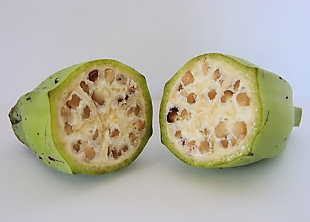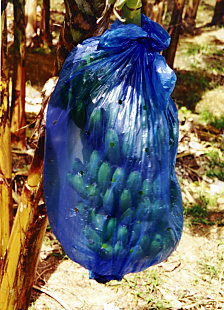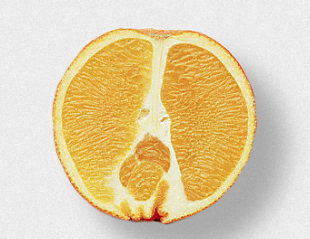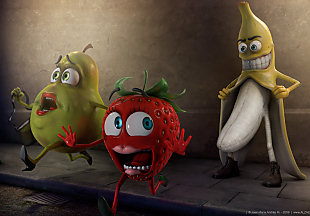
The humble banana almost seems like a miracle of nature. Colourful, nutritious, and much cherished by children, monkeys and clowns, it has a favoured position in the planet’s fruitbowls. The banana is vitally important in many regions of the tropics, where different parts of the plant are used for clothing, paper and tableware, and where the fruit itself is an essential dietary staple. People across the globe appreciate the soft, nourishing flesh, the snack-sized portions, and the easy-peel covering that conveniently changes colour to indicate ripeness. Individual fruit—or fingers—sit comfortably in the human hand, readily detached from their close-packed companions. Indeed, the banana appears almost purpose-designed for efficient human consumption and distribution. It is difficult to conceive of a more fortuitous fruit.
The banana, however, is a freakish and fragile genetic mutant; one that has survived through the centuries due to the sustained application of selective breeding by diligent humans. Indeed, the “miraculous” banana is far from being a no-strings-attached gift from nature. Its cheerful appearance hides a fatal flaw— one that threatens its proud place in the grocery basket. The banana’s problem can be summed up in a single word: sex.
The banana plant is a hybrid, originating from the mismatched pairing of two South Asian wild plant species: Musa acuminata and Musa balbisiana. Between these two products of nature, the former produces unpalatable fruit flesh, and the latter is far too seedy for enjoyable consumption. Nonetheless, these closely related plants occasionally cross-pollinate and spawn seedlings which grow into sterile, half-breed banana plants. Some ten thousand years ago, early human experimenters noted that some of these hybridized Musa bore unexpectedly tasty, seedless fruit with an unheard-of yellowness and inexplicably amusing shape. They also proved an excellent source of carbohydrates and other important nutrients.

A seed-packed wild musa (banana)Despite the hybrid’s unfortunate sexual impotence, shrewd would-be agriculturalists realised that the plants could be cultivated from suckering shoots and cuttings taken from the underground stem. The genetically identical progeny produced this way remained sterile, yet the new plant could be widely propagated with human help. An intensive and prolonged process of selective breeding—aided by the variety of hybrids and occasional random genetic mutations—eventually evolved the banana into its present familiar form. Arab traders carried these new wonderfruit to Africa, and Spanish conquistadors relayed them onwards to the Americas. Thus the tasty new banana was spared from an otherwise unavoidable evolutionary dead-end.
Today, bananas and their close relatives, the starchy plantains, grow in a number of different varieties or cultivars. Among temperate palates, the most familiar is the Cavendish, a shapely and sweet-tasting dessert banana. This is the banana found in the supermarkets, splits, and milkshakes of the developed world. It is exported on an industrial scale from commercial plantations in the tropics. Every Cavendish is genetically identical, possessing the same pleasant taste (which is somewhat lacking in more subtle flavours according to banana aficionados). They also all share the same potential for yellow curvaceousness and the same susceptibility to disease.
Although there are numerous other banana and plantain varieties cultivated for local consumption in Africa and Asia, none has the same worldwide appeal as the Cavendish. While these other varieties display more genetic variability, all come from the same sterile Musa hybrids which so delighted our forebears thousands of years ago. Likewise none of them have enjoyed the benefits of the frenzied gene-shuffling facilitated by sexual congress.
Stuck with the clunky, inefficient cloning of asexual reproduction, the sterile banana is at a serious disadvantage in the never-ending biological arms race between plant and pest. Indeed, it is a well-established fact that bananas are particularly prone to crop-consuming insects and diseases. A severe outbreak of banana disease could easily spread through the genetically uniform plantations, devastating economies and depriving our fruitbowls. Varieties grown for local consumption would also suffer, potentially causing mass starvation in tropical regions.

Banana bunches in protective isolation.This scenario may seem preposterous, but researchers all over the world are earnestly exploring the possibility. The custodians of the beloved banana are all too aware of the potential for a banana apocalypse— because it has already happened in the fruit’s past. And the next time could be much worse.
Until the middle of the twentieth century, most bananas on sale in the developed world belonged to the Gros Michel cultivar. These bananas were sweet and tasty and didn’t spoil too quickly, making them eminently suitable for commercial export. Old-timers contend that in flavour and convenience, the Gros Michel outshone even the current top-banana, the Cavendish. Yet from the early twentieth century, large plantations of ‘Big Mike’ proved increasingly fertile ground for a fungal leaf affliction known as Panama disease. Affected crops would soon deteriorate into rotting piles of unprofitable vegetation. As the century progressed, commercial growers found themselves in a desperate race against time, making doomed attempts to establish new plantations in disease-free areas of rainforest before the fungus arrived.
In the 1950s the Vietnamese Cavendish came to the rescue. Banana companies delayed switching from Big Mike for as long as possible due to the necessary changes in growing, storage, and ripening infrastructure, and many producers teetered on the edge of bankruptcy. As Big Mike started pushing up daisies, banana plantations frantically reconfigured, and by the mid 1960s the changeover was largely complete. The distinct—and now extinct—taste of Big Mike was quickly lost to the fickle public memory. Cavendish was king.
It has done a sterling job in the intervening years, yet now the Cavendish is starting to struggle in its own contest against contagion. In the 1970s a disease named Black Sigatoka was beaten back with enthusiastic applications of pesticide, but more recently a new strain of the original bane of the banana has threatened the plantations. Since 1992 a vigorous, pesticide-tolerant strain of Panama disease has been wiping out bananas—including previously resistant crops of Cavendish—in Southeast Asia. It has yet to reach the large commercial plantations in Latin America, but most banana-watchers believe that this is only a matter of time.
 A navel orange and its underdeveloped siamese twinOpinions differ on how long the Cavendish can survive the new onslaught, and on the best way to tackle the threat. This time, unfortunately, there is no obvious back-up variety waiting in the wings. So far, banana science has provided scant few approaches for improving disease resistance. One method involves the traditional techniques of selective breeding: although banana plants are clones, very occasionally they can be persuaded to produce seeds through a painstaking process of hand pollination. Only one fruit in three hundred will produce a seed, and of these seeds only one in three will have the correct chromosomal configuration to allow germination. The seeds are laboriously extracted by straining tons of mashed fruit through fine meshes. Research stations in commercial banana growing countries, such as Honduras, engage large squads of banana sex workers for such tasks, and to screen the new plant varieties for favourable characteristics.
A navel orange and its underdeveloped siamese twinOpinions differ on how long the Cavendish can survive the new onslaught, and on the best way to tackle the threat. This time, unfortunately, there is no obvious back-up variety waiting in the wings. So far, banana science has provided scant few approaches for improving disease resistance. One method involves the traditional techniques of selective breeding: although banana plants are clones, very occasionally they can be persuaded to produce seeds through a painstaking process of hand pollination. Only one fruit in three hundred will produce a seed, and of these seeds only one in three will have the correct chromosomal configuration to allow germination. The seeds are laboriously extracted by straining tons of mashed fruit through fine meshes. Research stations in commercial banana growing countries, such as Honduras, engage large squads of banana sex workers for such tasks, and to screen the new plant varieties for favourable characteristics.Another fruit subject to such human-assisted reproduction is the ubiquitous navel orange. It, too, was the result of a serendipitous mutation, this one from an orange tree in Brazil in the mid-1800s. Each orange on this particular tree was found to have a tiny, underdeveloped twin sharing its skin, causing a navel-like formation opposite the stem. These strange siamese citruses were much sweeter than the fruit of their parent trees, and delightfully seedless. Since the new tree was unable to reproduce naturally, caretakers amputated some of its limbs and grafted them onto other citrus trees to produce more of the desirable fruit. Even today navel oranges are produced through such botanical surgery, and all of the navel oranges everywhere are direct descendants—essentially genetic clones—of those from that original tree.
As for the Cavendish, its last best hope may lie in genetic modification (GM). The University of Leuven in Belgium is a world centre in banana research due to its colonial connections with Africa. Belgian banana scientists have become skilled in using DNA-transfer to introduce disease-resistance genes directly into the plant’s genome. These less labour-intensive methods promise a way to develop stronger, fitter, happier and more productive bananas.

“Fruity Flash” by José Mª Andrés Martín. Prints available.
In 2007, Ugandan field trials of the first Leuven uber-banana were announced, although public distaste of the idea of GM foods may impede its long term success. And in Honduras, researchers have developed a banana cultivar named ‘Goldfinger’ through traditional selective breeding methods. Although it has enjoyed some public acceptance in Australia, it suffers from the drawbacks of a distinctly different, non-Cavendish flavour, and a longer maturation time. If nothing else, these advances offer hope that science will one day overcome the unfortunate sexual inadequacies of the banana. Let us hope so, otherwise the resulting bananageddon will ensure that the Cavendish goes the way of Big Mike, and future generations of fruit lovers will have to find some other curved yellow food to complement their ice cream.

Male enhancement pills are few of the best male enhancement treatments which can help you overcome sexual problems such as erectile dysfunctions and premature ejaculations. You just have to understand how male enhancement techniques work for you to know what to do to achieve your required results. fitting prosolution pills website
ReplyDeleteWhen in doubt, talk to your urologists about a product that you have some interest in. Doctors are familiar with the herbs, natural compounds and minerals that play a role in strengthening the functioning of the male reproductive tract, particularly the prostate and the and the seminal vesicle.
ReplyDeleteThere’s nothing embarrassing about discussing your goal. In fact, your doctor can help you accomplish your goal in a safe and effective manner. thorough volume website
The link between erectile dysfunction and obesity is very strong. Before doing anything else, you may want to start doing aerobic exercises at least two to three times per week. Even a small decrease in your weight can produce serious improvements when it comes to the quality of your sex life.
ReplyDeletecompelling vigrxplus website
Growth hormone can be used to overcome problems like the loss of libido that often stems from aging in both men and women.
ReplyDeleteWhile testosterone supplements are particularly beneficial for guys who want to rejuvenate their sex drive, HGH supplementation will be equally beneficial for both genders. helpful genfx site
Natural male enhancement products come in all shapes and sizes – there are size increase pills, penis extenders, pumps, creams and even patches. You will first have to pick the product category that appeals the most to you.
ReplyDeleteOnce you accomplish the goal, you’ll next have to select the best product within the category. helpful volume pills
Colostrum is reach in proteins, growth factors, carbs, fats, vitamins and minerals. It also passes some antibodies from mom to baby, helping strengthen the immune system of a newborn. In fact, the level of antibodies in colostrum is approximately 100 times higher than the level in regular milk. concise male extra review
ReplyDeleteStronger bones: HGH speeds up bone regeneration. Several clinical studies prove its effectiveness for reducing the risk of fractures and promoting faster healing even after an injury occurs. full prosolution review here
ReplyDelete